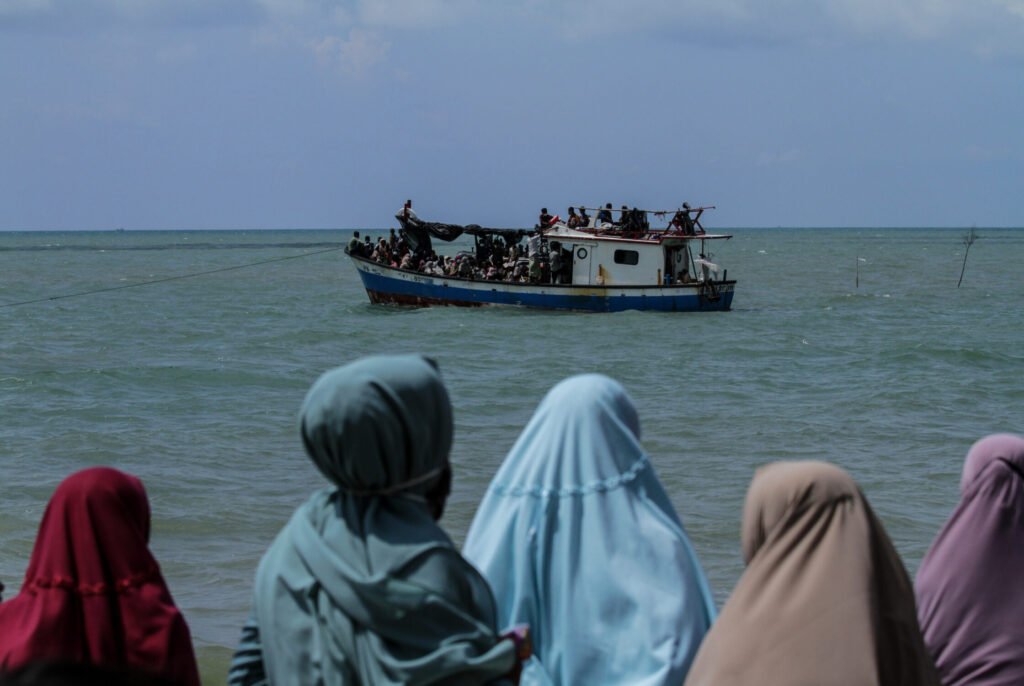By Adeola Ogunnoiki, PACS, University of Manitoba
Date: October 28, 2025
Exploitation in Exile: The Plight of Rohingya Women and Girls
Introduction
When Halima fled Myanmar, she thought she had escaped danger, she had not. Though she had survived the fires that burned her village, the soldiers who hunted her people, and the endless trek through jungle and mud with nothing but fear to guide her steps. However, in the refugee camp where she sought safety, a new kind of predator awaited; one that did not carry guns or wear uniforms, yet was just as dangerous. This predator hides behind kind faces and empty promises. It whispers of jobs in the city, of marriages that could bring stability, of a better life beyond the refugee camp. It comes in the form of traffickers; men and women who exploit desperation, turning Rohingya suffering into profit.
For thousands of Rohingya women and children like Halima, that hope leads straight into captivity: forced prostitution, abusive “marriages,” or labour that strips away their freedom and dignity.
It is important to note that Halima’s story is not unique. For example, data from international organizations for Migration (IOM) reveal how widespread this exploitation has become. According to a 2017 IOM survey, about 99 cases of human trafficking or exploitation involving Rohingya refugees in Bangladesh were identified. Of those about 35 were girls and 31 were women. In the same vein, between July and September 2024, the Anti-Trafficking Working Group (ATWG) reported about 86 victims of human trafficking among Rohingya refugees in the camps. Of these, about 6% were trafficked for sexual exploitation, and about 5% for forced marriage.
The concept of sex trafficking
Sex trafficking refers to a severe form of human exploitation where individuals often women and children are coerced, deceived, or forced into sexual acts for the profit or benefit of others. It is one of the most widespread and brutal forms of human trafficking and a grave violation of human rights. Sex trafficking has become the silent shadow of displacement. For the Rohingya,
traffickers exploit their lack of citizenship, education, and livelihood opportunities, often luring victims from refugee camps in Bangladesh into forced sex work or abusive marriages abroad.
Who are the Rohingyas?
The Rohingya are a Muslim ethnic minority from Rakhine State in western Myanmar. For generations they lived there, speaking a dialect related to Chittagonian Bengali and practicing Islam in a mostly Buddhist country.
The crisis that forced the Rohingya to flee Myanmar?
After Myanmar’s independence, the Rohingyas were stripped of their legal status, and the 1982 Citizenship Law left them officially stateless. Denied education, healthcare, and freedom of movement, they have endured waves of persecution. The army’s 2017 crackdown burned villages, killed thousands, and drove more than 700 000 people into Bangladesh, where nearly a million Rohingya now live in refugee camps such as Cox’s Bazar. Today they are widely described by the United Nations as one of the most persecuted and vulnerable populations on earth, trapped between statelessness, poverty, and exploitation; including the growing risk of trafficking and sexual violence.
Why Rohingya Women and Children Are Vulnerable?
For the Rohingya, the danger of sex trafficking is rooted in their statelessness and displacement. Stripped of citizenship and legal protection, they live in overcrowded refugee camps where poverty, hunger, and hopelessness are part of daily life. Most are forbidden to work or move freely, leaving families desperate for income and opportunity.
Traffickers exploit this desperation. They target women and children with promises of jobs, education, or marriage; offers that seem like a way out but often lead to abuse and exploitation. Limited access to education and information means many don’t recognize the danger until it’s too late. In these fragile environments, trafficking thrives in silence. Fear, stigma, and lack of justice keep victims from speaking out, while traffickers operate with impunity. For many Rohingya women and girls, the search for safety has tragically become another journey into danger.
The Human Cost: Lives Behind the Numbers
Behind every statistic on sex trafficking lies a human story; one of pain, loss, and survival. For the Rohingya, these stories are not numbers on a report; they are the faces of mothers, daughters, sisters, and children who have endured the unimaginable.
Survivors of sex trafficking often describe a journey that begins with hope and ends in horror. Many are promised work as domestic helpers, factory workers, or brides abroad. Instead, they find themselves locked in rooms, their passports taken, their freedom stolen. Physical abuse, sexual violence, and psychological trauma become part of everyday life.
Even when survivors manage to escape, the suffering rarely ends. Returning to the camps, they face stigma, shame, and silence. Some are rejected by their families; others hide their stories out of fear. Access to counselling, medical care, or justice is scarce. In many cases, traffickers remain unpunished, continuing to prey on new victims.
The trauma ripples through entire communities; mothers fearing for their daughters, children growing up in fear, and families fractured by loss. For the Rohingya women and children, sex trafficking is not just an individual tragedy; it is a collective wound that deepens their struggle for dignity and safety.
It is important to note that sex trafficking among the Rohingya is not just a local tragedy; it is part of a wider regional web of crime and vulnerability. Traffickers move easily across porous borders, connecting networks that stretch from Bangladesh to Myanmar, India, and Malaysia. In a region where law enforcement is overstretched and resources are limited, these criminal groups thrive in the shadows, preying on those who have no legal status or protection. In response, international organizations such as UNHCR and the International Organization for Migration (IOM) are working alongside the Bangladeshi government and local NGOs to fight against this issue.
In the next part, I will look at the push and pull factors driving sex trafficking among Rohingya women and children, as well as the roles of law enforcement, NGOs, and civil society organizations in safeguarding and supporting them.
To be continued…
Photo credit: https://www.refugeesinternational.org/advocacy-letters/the-situation-of-the-rohingya-and-deadly-sea-crossings



